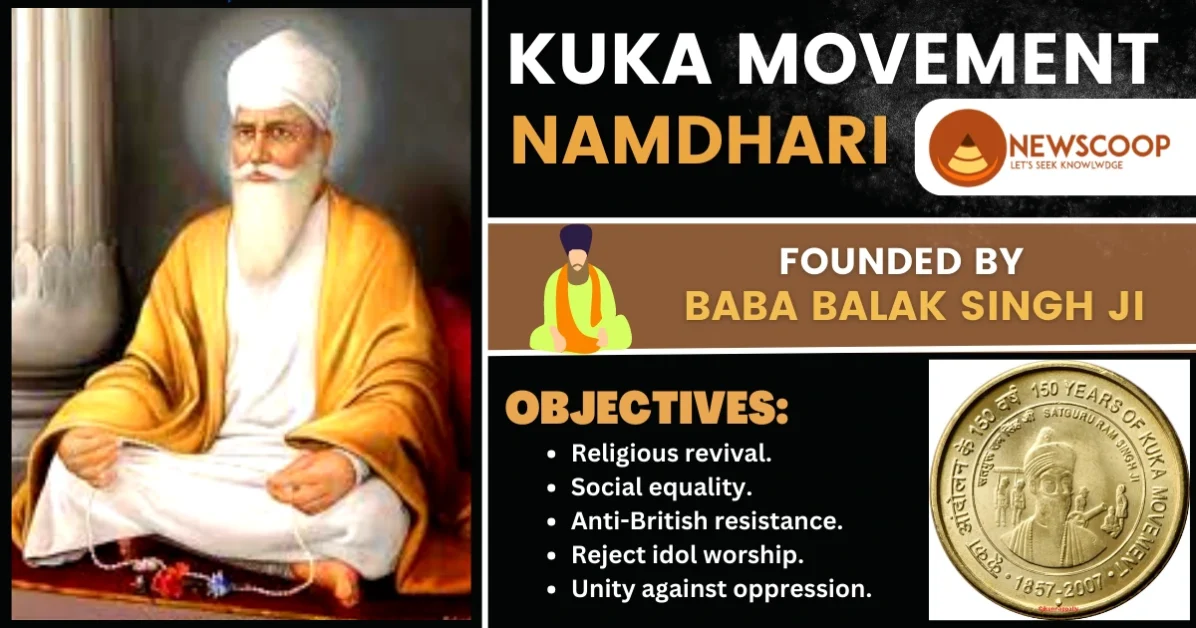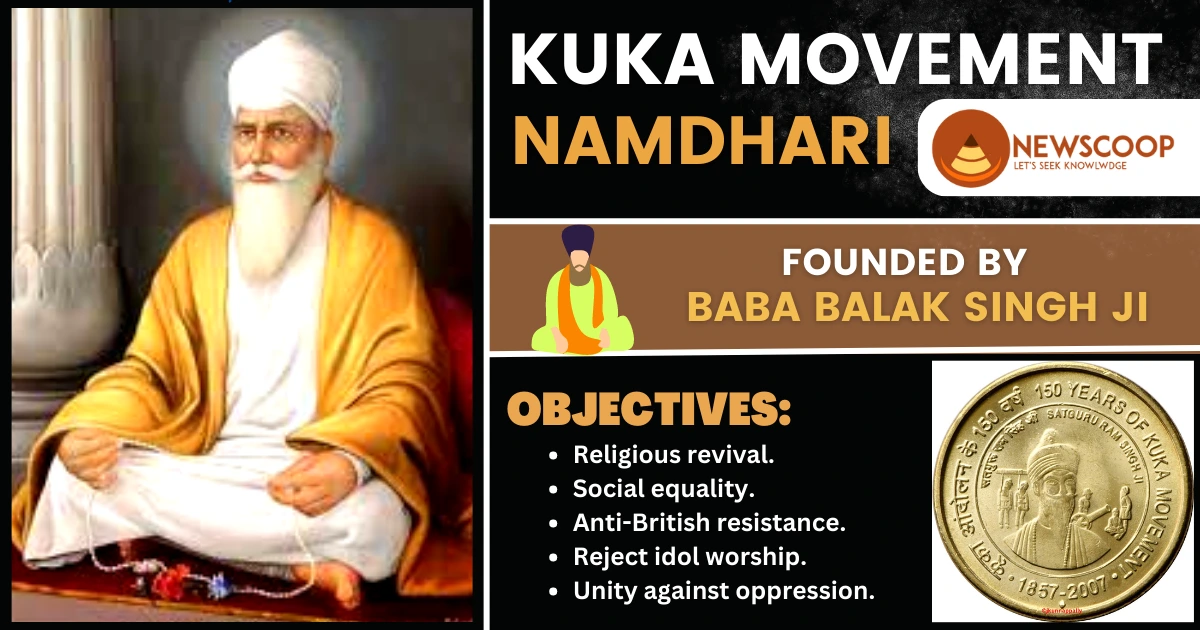Kuka and Namdhari Movement
The Kuka Movement also known as the Namdhari Movement was a significant part of India’s struggle for freedom against British rule. It began in the late 19th century and was led by Sikh leaders who wanted to resist British colonialism, unfair economic practices, and social injustices.
In this article, we will explore where the Kuka Movement came from, what it stood for, and how it influenced India’s fight for independence.
Kuka/Namdhari Movement
The Kuka Movement’s evolution from the followers of Baba Balak Singh and Bhagat Jawar Mal to the Namdharis, who became known for their distinctive religious practices, is an important aspect of its history.
The nickname “Kukas,” derived from the Punjabi word “kook” (meaning to cry), reflects the emotional and fervent nature of their religious practices, which involved chanting Sikh mantras and repeating names with great intensity.
The unique attire of the Namdharis, characterized by white clothing and distinctive headgear, helped distinguish them as a community dedicated to their religious beliefs and social ideals. Their practices and attire symbolized their commitment to religious purity and socio-economic reform, which were central tenets of the Kuka Movement.
The Kuka Movement was initially a socio-religious reform movement in 19th-century Punjab, founded by Guru Ram Singh. However, it later experienced a violent uprising in 1871, characterized by internal divisions, attacks on butchers and cow slaughter opponents, and even the targeting of religious buildings.
This violent phase diverted attention from the movement’s original goals but eventually evolved back towards religious piety and socio-economic reform.
Objectives of the Kuka Movement
Here are the key objectives of the Kuka Movement:
- Religious revival and return to Sikhism’s original teachings.
- Advocated socio-economic equality and challenged the feudal system.
- Resisted British colonial rule through non-cooperation and civil disobedience.
- Uniting various sections of society against British authority.
- Baba Ram Singh’s leadership was central to the movement’s direction and actions.
Centers of Kuka Movement
It had numerous centers across the country, with approximately 22 major centers being pivotal in its activities:
- Amritsar
- Ludhiana
- Hoshiarpur
- Jalandhar
- Patiala
- Bathinda, etc.
Founder of the Kuka Movement
- The Kuka Movement was originally founded by Baba Balak Singh (a follower of Bhagat Jawahar Mal).
- Baba Ram Singh later emerged as a significant leader within the movement, following Baba Balak Singh’s leadership.
- Together, they played vital roles in shaping the movement’s objectives and actions.
Baba Ram Singh
Baba Ram Singh, the visionary behind the Kuka Movement, emerged from humble beginnings. Born in 1815 in the small town of Bhaini, located approximately 7 kilometers from Ludhiana in Punjab, Baba Ram Singh’s early life was far from extravagant. His father worked as a carpenter, and it was in this modest environment that Baba Ram Singh’s journey would begin.
In the early 1840s, Baba Ram Singh took on the role of a soldier in the Sikh Army under Prince Naunihal Singh. This period coincided with the turbulent times of the Sikh Empire in India. However, the downfall of the Sikh regime led to significant changes in Baba Ram Singh’s life. Following the overthrow of the Sikh rule, he decided to resign from his military position.

Baba Ram Singh’s spiritual journey and his involvement in the Kuka Movement were greatly influenced by his interactions with other prominent figures of his time. In 1838, he crossed paths with Baba Balak Singh, a spiritual leader who played a pivotal role in the early development of the Kuka Movement.
Additionally, Baba Ram Singh maintained connections with Bhagat Jawar Mal, further shaping his beliefs and principles.
Religious Aspects of the Kuka Movement
- Return to original Sikhism teachings.
- Emphasis on simplicity and devotion.
- Rejection of idol worship.
- Community-based religious practices.
- Study of Sikh scriptures, particularly Guru Granth Sahib.
- Religious singing and chanting.
- Distinctive white attire symbolizes purity.
- Rejection of the caste system.
- Regular congregational worship and gatherings.
Government Actions & Kuka Movement
Detention and Execution: The Kuka Movement faced harsh government actions during its struggle against British colonial rule. Many Kuka leaders and followers were detained by the British authorities, and a significant number of them faced execution. These executions underscore the severity of measures employed by the colonial administration to suppress the movement.
Occupation of Malerkotla: In 1872, a faction of Kukas, disenchanted with the leadership of Baba Ram Singh, decided to take matters into their own hands by attacking and occupying Malerkotla. This event triggered a substantial outbreak of violence, exacerbating the already tense relationship between the Kukas and the British authorities.
Government’s Aggressive Response: The British colonial government responded to the occupation of Malerkotla with unrelenting force. Cannon fire was used to quell the uprising, resulting in the destruction of many Kuka ringleaders. This heavy-handed response illustrated the government’s determination to suppress any form of resistance.
Misinterpretation of Ram Singh’s Intentions: Despite Baba Ram Singh’s claims that certain individuals had misappropriated his name and actions, the colonial administration construed his motives differently. They believed that Ram Singh’s true intention was to attain political power and amass dominion under the guise of religious reform. This misunderstanding further escalated the conflict.
Exile and Death of Baba Ram Singh: As a consequence of the government’s actions, Baba Ram Singh was apprehended and subsequently exiled to Burma. He spent the remainder of his life in exile, tragically perishing there. This marked the end of his leadership within the Kuka Movement and highlighted the high personal cost incurred by leaders of anti-colonial movements during that era.
Also Read: Khilafat Movement
Conclusion
In conclusion, the Kuka Movement was a significant socio-religious and political movement in Punjab during the late 19th century. It aimed to reform Sikhism, address social inequalities, and resist British colonial rule.
Despite facing government repression, it left a lasting impact on Sikhism and played a role in India’s struggle for independence.
Thank You!
FAQs
What is the Kuka Movement?
The Kuka Movement, also known as the Namdhari Movement, was a socio-religious and political movement that emerged in the Punjab region of India during the late 19th century.
Who was the founder of the Kuka Movement?
The Kuka Movement, also known as the Namdhari Movement, was founded by Baba Balak Singh.

